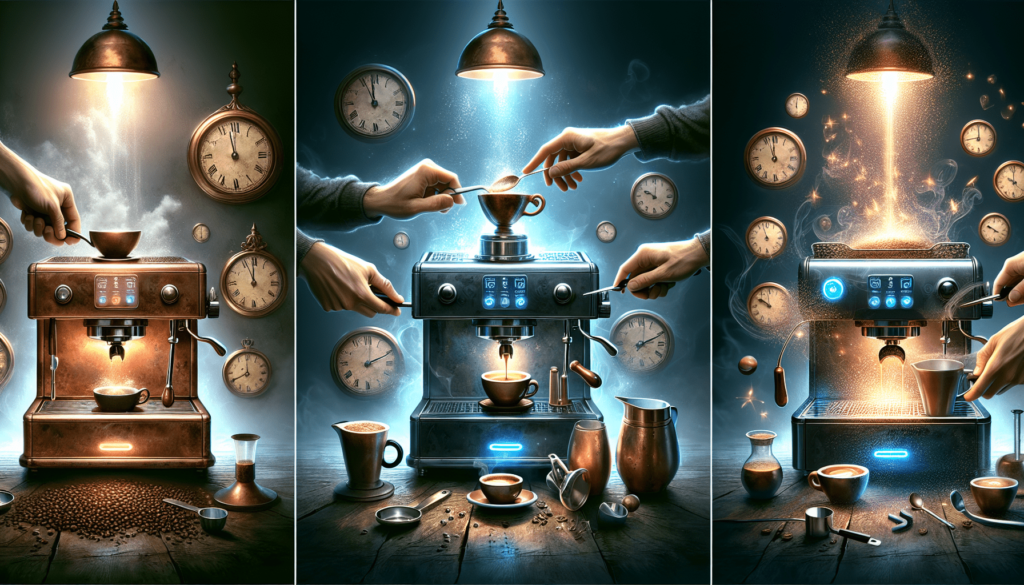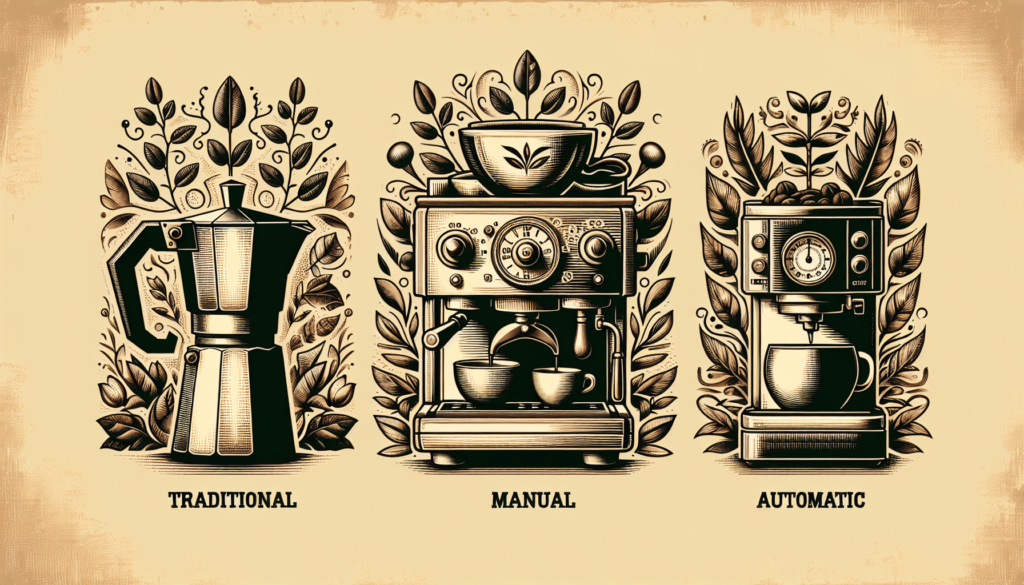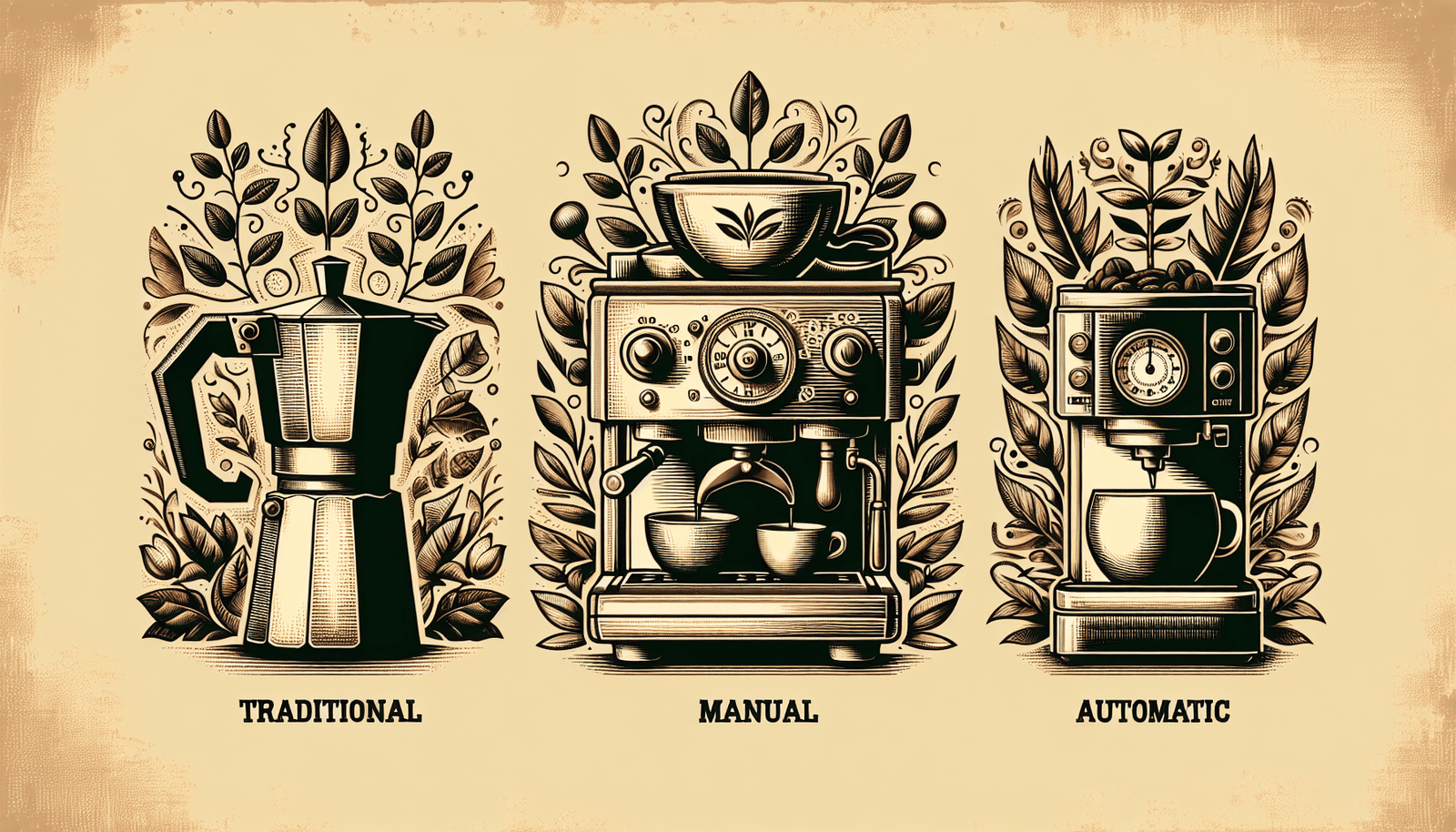If you’re a coffee lover, you know the satisfaction that comes with a perfectly brewed cup of espresso. But have you ever wondered about the different brewing methods that can achieve this aromatic and flavorful beverage? From the classic espresso machine to alternative methods like the Aeropress or French press, this article explores the various ways you can brew your own espresso at home. Get ready to upgrade your coffee game and discover the endless possibilities of brewing methods for espresso!
1. Traditional Espresso Machine
1.1. Description
The traditional espresso machine, also known as the manual espresso machine, is a classic piece of equipment that has been used for decades to brew delicious espresso. It consists of a group head, a portafilter, a boiler, and a steam wand. This machine requires manual operation to control the brewing process and create the perfect shot of espresso.
1.2. Equipment
To use a traditional espresso machine, you will need a few essential pieces of equipment. Firstly, you will need the espresso machine itself, which includes all the necessary components mentioned earlier. Additionally, you will need freshly ground coffee beans, a tamper to evenly distribute the coffee in the portafilter, a coffee grinder to grind the beans to the appropriate consistency, a scale to measure the coffee and water, and a timer to ensure precision in the brewing process.
1.3. Brewing Process
Using a traditional espresso machine requires a certain level of skill and precision. To brew espresso, start by preheating the machine and the cups. Next, grind your coffee beans to a fine consistency and measure the desired amount of coffee using a scale. Place the grounds into the portafilter and use a tamper to evenly distribute the coffee. Insert the portafilter into the group head of the machine.
Start the brewing process by activating the pump, which forces hot water through the coffee grounds and into the cup. This process should take approximately 25 to 30 seconds to complete. The resulting espresso shot should have a rich, flavorful crema on top. Adjust the brewing time and grind size as necessary to achieve your desired taste.
2. Piston Espresso Machine
2.1. Description
The piston espresso machine, also known as a manual lever espresso machine, is a classic and elegant option for brewing espresso. This type of machine operates using a lever mechanism to manually exert pressure on the coffee grounds and extract the espresso.
2.2. Equipment
To use a piston espresso machine, you will need the machine itself, which consists of a lever, a piston, and a group head. Additionally, you will need freshly ground coffee beans, a tamper, a coffee grinder, a scale, and a timer.
2.3. Brewing Process
Using a piston espresso machine involves a hands-on brewing process. To start, preheat the machine and the cups. Grind your coffee beans to a fine consistency and measure the desired amount of coffee using a scale. Distribute the coffee evenly in the portafilter and tamp it down with a tamper.
Next, using the lever, manually exert downward pressure on the coffee grounds to extract the espresso. This process requires precision and control to achieve the optimal brewing time, typically around 25 to 30 seconds. Adjust the pressure exerted with the lever, as well as the grind size, to fine-tune the taste of your espresso shot.

3. Lever Espresso Machine
3.1. Description
The lever espresso machine is another manual option for brewing espresso. This type of machine utilizes a lever mechanism to generate pressure and extract the espresso. Lever espresso machines are known for their simplicity and ability to produce high-quality espresso shots.
3.2. Equipment
To use a lever espresso machine, you will need the machine itself, which includes a lever, a piston, and a group head. You will also need freshly ground coffee beans, a tamper, a coffee grinder, a scale, and a timer.
3.3. Brewing Process
Using a lever espresso machine involves a straightforward yet manual brewing process. Begin by preheating the machine and the cups. Grind your coffee beans to the desired consistency and measure the appropriate amount of coffee using a scale. Distribute the coffee evenly in the portafilter and tamp it down with a tamper.
Once the machine is heated and ready, pull down the lever to activate the brewing process. This action will generate pressure and force hot water through the coffee grounds, extracting the espresso. The brewing time should be around 25 to 30 seconds. Adjust the pressure exerted with the lever and the grind size to achieve the desired taste and crema.
4. Pump Espresso Machine
4.1. Description
The pump espresso machine is a popular choice for espresso enthusiasts due to its convenience and consistent brewing capabilities. This type of machine utilizes a pump to create the necessary pressure for brewing espresso, providing a hands-free brewing experience.
4.2. Equipment
To use a pump espresso machine, you will need the machine itself, which includes a pump, a boiler, and a group head. Additionally, you will need freshly ground coffee beans, a tamper, a coffee grinder, a scale, and a timer.
4.3. Brewing Process
Using a pump espresso machine offers a convenient and automated brewing process. Begin by preheating the machine and the cups. Grind your coffee beans to the desired consistency and measure the appropriate amount of coffee using a scale. Distribute the coffee evenly in the portafilter and tamp it down with a tamper.
Once everything is ready, simply press a button or switch to activate the pump, which will force hot water through the coffee grounds and extract the espresso. The brewing time should be around 25 to 30 seconds. Adjust the grind size and brewing time as needed to achieve your desired taste.

5. Super-automatic Espresso Machine
5.1. Description
The super-automatic espresso machine is the pinnacle of convenience in the world of espresso brewing. This type of machine handles all aspects of the brewing process, from grinding the coffee beans to extracting the espresso, with minimal effort required from the user.
5.2. Equipment
To use a super-automatic espresso machine, you will need the machine itself, which includes a built-in grinder, a brewing unit, and a control panel. Additionally, you will need coffee beans and water.
5.3. Brewing Process
Using a super-automatic espresso machine is incredibly simple and user-friendly. Begin by filling the machine’s water reservoir and adding coffee beans to the built-in grinder. Adjust the settings on the control panel to customize your preferred strength and volume of espresso.
After the machine grinds the beans, it will automatically tamp them and extract the espresso using a pre-set brewing time. The machine will then dispose of the used coffee grounds and be ready to brew another shot. With a super-automatic espresso machine, you can enjoy a delicious cup of espresso with just the push of a button.
6. Semi-automatic Espresso Machine
6.1. Description
The semi-automatic espresso machine offers a balance between manual control and convenience. This type of machine allows the user to control the brewing process while still providing automated features for grinding and steaming milk.
6.2. Equipment
To use a semi-automatic espresso machine, you will need the machine itself, which includes a pump, a boiler, and a group head. Additionally, you will need freshly ground coffee beans, a tamper, a coffee grinder, a scale, and a timer.
6.3. Brewing Process
Using a semi-automatic espresso machine requires some hands-on involvement. To begin, preheat the machine and the cups. Grind your coffee beans to the desired consistency and measure the appropriate amount of coffee using a scale. Distribute the coffee evenly in the portafilter and tamp it down with a tamper.
Once everything is set up, activate the pump by pressing a button or switch to extract the espresso. Control the brewing time manually, typically aiming for 25 to 30 seconds. Use the steam wand to froth milk if desired, adjusting the machine’s settings to achieve the desired level of steam and temperature.
7. Pod Espresso Machine
7.1. Description
The pod espresso machine offers simplicity and convenience by using pre-packaged espresso pods or capsules. This type of machine requires minimal effort, making it a popular choice for those seeking a quick and hassle-free espresso brewing experience.
7.2. Equipment
To use a pod espresso machine, you will need the machine itself, which includes a pod or capsule holder, a water reservoir, and a control panel. Additionally, you will need espresso pods or capsules.
7.3. Brewing Process
Using a pod espresso machine is incredibly straightforward. Begin by filling the water reservoir and inserting the desired pod or capsule into the designated holder. Adjust any settings on the control panel to customize the strength and volume of your espresso, if applicable.
Once everything is prepared, simply press a button or switch to start the brewing process. The machine will automatically pierce the pod or capsule, extract the espresso, and dispense it into your cup. With a pod espresso machine, you can enjoy a cup of espresso with minimal effort and cleanup.
8. Stovetop Espresso Maker
8.1. Description
The stovetop espresso maker, also known as a moka pot, is a classic and affordable option for brewing espresso at home. This type of brewing method utilizes steam pressure created by heating water in a bottom chamber to extract the espresso.
8.2. Equipment
To use a stovetop espresso maker, you will need the pot itself, which includes a bottom chamber, a filter basket, and a top chamber. Additionally, you will need freshly ground coffee beans and a heat source, such as a stovetop or a hot plate.
8.3. Brewing Process
Using a stovetop espresso maker is relatively simple. Start by filling the bottom chamber with water up to the indicated level. Place the filter basket on top of the bottom chamber and fill it with finely ground coffee, leveling it off without tamping.
Screw the top chamber onto the bottom chamber tightly, ensuring a secure seal. Place the stovetop espresso maker on the heat source and wait for the water in the bottom chamber to boil. As the water boils, the steam pressure will build and force hot water through the coffee grounds, extracting the espresso into the top chamber.
Once the top chamber is filled with the desired amount of espresso, remove the pot from the heat source and allow it to cool slightly before serving the espresso.
9. Aeropress
9.1. Description
The Aeropress is a popular and versatile brewing device that allows for a wide range of espresso-style drinks. It uses a combination of immersion and pressure to extract coffee, resulting in a smooth and flavorful cup of espresso.
9.2. Equipment
To use an Aeropress, you will need the device itself, which consists of a brewing chamber, a plunger, and a filter cap. Additionally, you will need freshly ground coffee beans, a coffee grinder, a kettle to heat water, and a timer.
9.3. Brewing Process
Using an Aeropress is relatively simple and allows for customization in the brewing process. Begin by preheating the Aeropress and your cup. Grind your coffee beans to a medium-fine consistency and measure the desired amount of coffee using a scale.
Assemble the Aeropress by placing a filter in the filter cap and attaching it to the brewing chamber. Place the brewing chamber on top of your cup. Add the coffee grounds to the chamber, followed by hot water at the desired temperature. Stir the mixture gently to ensure all the grounds are saturated.
After a brief steeping period, insert the plunger into the brewing chamber and apply gentle pressure to extract the espresso. The entire brewing process should typically take around 1 to 2 minutes. Adjust the grind size, water temperature, and brewing time to experiment with different flavors and strengths.
10. Moka Pot
10.1. Description
The Moka Pot, also known as a stovetop espresso maker, is a classic Italian brewing device that produces a strong and rich espresso-like coffee. It uses steam pressure to force water through the coffee grounds and extract the coffee.
10.2. Equipment
To use a Moka Pot, you will need the device itself, which consists of a bottom chamber, a filter basket, and a top chamber. Additionally, you will need freshly ground coffee beans and a heat source such as a stovetop or a hot plate.
10.3. Brewing Process
Using a Moka Pot is relatively straightforward. Begin by filling the bottom chamber with water up to the indicated level. Place the filter basket on top of the bottom chamber and fill it with finely ground coffee, leveling it off without tamping.
Screw the top chamber onto the bottom chamber tightly, ensuring a secure seal. Place the Moka Pot on the heat source and wait for the water in the bottom chamber to boil. As the water boils, the steam pressure will build and force hot water through the coffee grounds, extracting the espresso-like coffee into the top chamber.
Once the top chamber is filled with the desired amount of coffee, remove the Moka Pot from the heat source and allow it to cool slightly before serving. Enjoy the intense and flavorful result of the Moka Pot brewing method.
In conclusion, there are various brewing methods for espresso, each offering unique characteristics and levels of control. Whether you prefer a hands-on approach with a manual espresso machine or the convenience of a super-automatic machine, there is a method that suits your preferences. Understanding the equipment needed and the brewing processes involved will allow you to choose the perfect brewing method and create your perfect cup of espresso. So go ahead, explore the world of espresso brewing methods, and discover the one that brings you the most enjoyment. Happy brewing!

